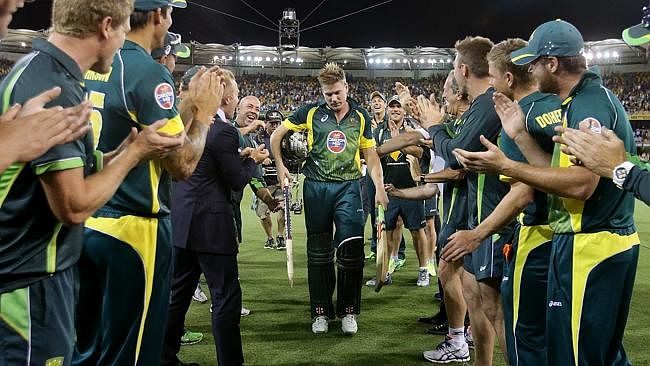
Australia's tail makes them World Cup favourites

Every World Cup sees a lot of changes in cricket. The 1983 World Cup saw the introduction of the 30-yard fielding circle. The 1987 event was the first 50-over World Cup. The 1992 edition of the quadrennial event saw coloured clothes, day-and-night matches, and white balls.
The rules have continued to change: from 15-over fielding restrictions upfront to 20-over restrictions including a batting and a bowling powerplay and back to 15-over restrictions but with the batting powerplay.
The impact of the most recent rule changes in ODI cricket
The 2015 edition is also seeing some new rules in ODI cricket that its predecessors did not see. There has been some tweaking with the batting powerplay, which has to be taken before the 40th over now, and the bowlers (at least the pacers) have been given something to cheer with the introduction of two bouncers per over and two new balls, even though the latter takes reverse-swing out of the equation.
However, the most significant change the World Cup Down Under will witness is the rule of only 4 fielders outside the 30-yard circle, even in the non-powerplay overs.
This outlandish rule, which has virtually reduced bowlers to bowling machines, has been in use since November 2012. Not surprisingly, in these 27 months, we have seen two massive records – the fastest century and the highest ever individual score in an ODI – being broken twice. The 350-mark has been breached a whopping 15 times, twice in a losing cause. There is no doubt that this rule will impact the World Cup immensely.
The teams, and especially the captains, though, can’t complain of not having enough time to adjust to it.
Australia – the team that has adapted the best to the demands
The team that has best adjusted to this rule (and all others) is clearly Australia. The Aussies have a win-loss record of 2.15 since November 2012. One may argue that they have played most of their cricket at home, but that is where the World Cup is going to be played.
Australia have realized quickly that ODIs have become a competition between two sets of batsmen rather than a fair battle between bat and ball, and they responded wonderfully to the new changes. In their World Cup squad, the kangaroos have picked as many as 6 all-rounders – and that is without counting the likes of Steven Smith. They have only two members in the 15 who can’t contribute much with the bat – pacer Josh Hazlewood and the lone spinner, Xavier Doherty. Both of them are unlikely to make it to the first XI.
While the top 6 of every team balance one another, it is the last 5 that makes the Australians phenomenally strong. The Australian lower order is likely to have any 4 of Glen Maxwell, James Faulkner, Mitchell Marsh, Mitchell Johnson, Mitchell Starc and Pat Cummins along with wicket-keeper Brad Haddin from 7 to 11.
Thus, in a big chase or while setting up an imposing total, the likes of David Warner, Aaron Finch and Shane Watson have the luxury to go hammer and tongs at the top knowing that they have Smith, Michael Clarke and George Bailey to anchor the middle phases and the likes of Faulkner or Marsh to finish off the innings at the end.
While most teams will be depending on their top 6 to see off every match, the Australian tail (if one may call it a tail) is perfectly capable of scoring at 10-12 an over in the end. This luxury might be Australia’s biggest asset in the home World Cup as they plan to regain the trophy that they had made their own throughout the noughties.